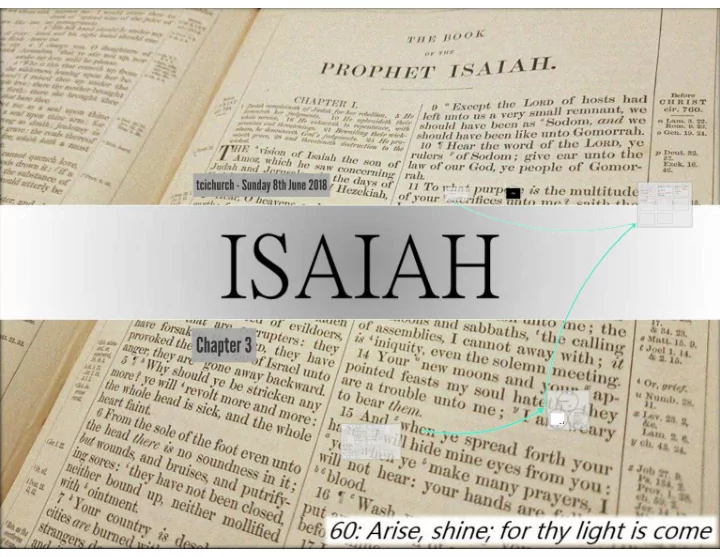

Isaiah 3:18-24 THE BRAVERY OF THEIR TINKLING ORNAMENTS
The ornaments of Isaiah 3 [ 18 ] In that day the Lord will take away the bravery of their tinkling ornaments about their feet, and their cauls, and their round tires like the moon, [ 19 ] The chains, and the bracelets, and the mufflers, [ 20 ] The bonnets, and the ornaments of the legs, and the headbands, and the tablets, and the earrings, [ 21 ] The rings, and nose jewels, [ 22 ] The changeable suits of apparel, and the mantles, and the wimples, and the crisping pins, [ 23 ] The glasses, and the fine linen, and the hoods, and the vails. [ 24 ] And it shall come to pass, that instead of sweet smell there shall be stink; and instead of a girdle a rent; and instead of well set hair baldness; and instead of a stomacher a girding of sackcloth; and burning instead of beauty.
Caul – What is a caul? the amniotic membrane enclosing a fetus. • a woman's close-fitting indoor headdress or hairnet. •
Caul A caul fits at the back of the head, where it is held on by pins or combs. As Elizabethan women almost always had long hair, they wrapped it into a bun or coil at the back of their head and placed the caul over it; the hair helped to keep the caul in place, aided with pins and perhaps combs.
Not to be confused with a Snood The Elizabethan gentlewoman didn't wear a snood per se. She did wear something similar, which was called a "caul". A caul was a small bag pinned over the bun and hair at the back of the head What is a snood? Sounds like something from Dr Seuss
http://www.elizabethancostume.net/headwear/caulmake.html http://www.womeninthescriptures.com/2009/03/daughters-of-zion.html
round tires like the moon "To tire" the head is to adorn it Same origin as the word tiara Ezekiel 24:17 [ 17 ] Forbear to cry, make no mourning for the dead, bind the tire of thine head upon thee, and put on thy shoes upon thy feet Isaiah 3:18 the word saharonim is rendered "round tires like the moon,"
Tablets [ 20 ] The bonnets, and the ornaments of the legs, and the headbands, and the tablets, and the earrings, literally houses of breath or smell thought to have been perfume boxes or smelling bottles, suspended from their girdles
Mantles, Wimples and Crisping pins "... changeable suits of apparel, and the mantles , and the wimples , and the crisping pins ..."
Mantle a loose sleeveless cloak or shawl, worn especially by women an Eastern Orthodox vesture worn by monastics and higher clergy
Wimples Hebrew word is only used twice in the entire Old Testament. Once in Isaiah The other time it is used it is translated as "the vail" in Ruth 3:15 - "Bring the VAIL that thou hast upon thee, and hold it."
Wimples A wimple in the 16th century referred to a long a cloth which covered the head, neck, and chin. Today some nuns, who wear the traditional dress, still wear wimples. In Isaiah may have just been shawls or a type of cloaks. may have been similar to the traditional headdress and dress of Arab women
Crisping Pins Hebrew word is only used 2 times in the Old Testament 2 Kings 5:23 it is translated as "bags" "And Naaman said, Be content, take two talents. And he urged him, and bound two talents of silver in two BAGS". Isaiah 3:22 Crisping pins could either have been a heated piece of metal around which the woman's hair was curled or "crisped" to leave a curl a pin that was placed around a curl of hair to keep it in place. http://brandplucked.webs.com/wimplescrispingpins.htm
Stomacher "... instead of a stomacher a girding of sackcloth ...“ a V-shaped piece of decorative cloth, worn over the chest and stomach by men and women in the 16th century, later only by women.
Sackcloth is a term originally denoting a coarsely woven fabric, usually made of goat's hair. It later came to mean also a garment made from such cloth, chiefly worn as a token of mourning by the Israelites. It was a sign of submission 2 Samuel 3:31 31 And David said to Joab, and to all the people that were with him, Rend your clothes, and gird you with sackcloth, and mourn before Abner. And king David himself followed the † bier.
The ornaments of Isaiah 3 [ 18 ] In that day the Lord will take away the bravery of their tinkling ornaments about their feet, and their cauls, and their round tires like the moon, [ 19 ] The chains, and the bracelets, and the mufflers, [ 20 ] The bonnets, and the ornaments of the legs, and the headbands, and the tablets, and the earrings, [ 21 ] The rings, and nose jewels, [ 22 ] The changeable suits of apparel, and the mantles, and the wimples, and the crisping pins, [ 23 ] The glasses, and the fine linen, and the hoods, and the vails. [ 24 ] And it shall come to pass, that instead of sweet smell there shall be stink; and instead of a girdle a rent; and instead of well set hair baldness; and instead of a stomacher a girding of sackcloth; and burning instead of beauty.
Recommend
More recommend